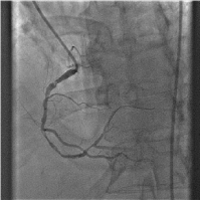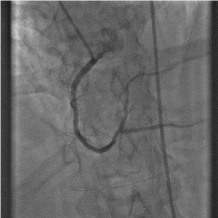Key words
Prolonged resuscitation, Ventricular fibrillation, cardiac arrest, cardiac etiology
Case-report
A 51 year old male presented to the Emergency Department (ED) in cardiac arrest. He was found down outside the hospital, where bystander basic life support reanimation was initiated. He received an estimated 10 minutes of manual CPR, then, after emergency medical services (EMS) arrival, advanced cardiac life support treatment was initiated including endotraqueal intubation and chest compressions with Lund University Cardiopulmonary Assist System (LUCAS). The initial rhythm was ventricular fibrillation. He was defibrillated for seven times, and received 1 mg epinephrine, 300 mg IV amiodarone, followed by 1mg epinephrine and 150 mg IV amiodarone.
On arrival at the ED (after 25 minutes of pre-hospital CPR), the patient continued on refractory ventricular fibrillation and advanced cardiac life support treatment was followed. His continuous end tidal CO2 readings throughout the case averaged above 20s mmHg (a sign of effective CPR).LUCAS chest compressions were continued. The emergency department cardiac arrest team continued with high quality CPR and ACLS medications including epinephrine,sodium bicarbonate, and lidocaine 1, 5 mg/kg IV were given to the patient, as well as 2 g of magnesium empirically. After 30 minutes of
ED CPR and 25 minutes of out of hospital CPR (total time 55 minutes), return of spontaneous circulation (ROSC) was obtained, with a corresponding increase in end tidal CO2 from the 20 mmHg range to 50mmHg. An ECG was obtained showing ST elevation in diaphragmatic wall. The cardiac catheterization lab was activated, and the patient was transferred for the cardiac coronary unit and percutaneous coronary intervention (PCI) was made, which showed an important lesion in the proximal right coronary artery (Figure 1). A drug eluting stent was placed (Figure 2), with a good hemodinamic result.

Figure 1.ECG showing ST elevation in diaphragmatic wall.

Figure 2.ECG showing drug eluting stent.
The patient was hospitalized 1 month after his cardiac arrest in the cardiology department. His hospital course was complicated by an episode of nosocomial Pneumonia. His post arrest echocardiogram showed an Ejection Fraction of around 30%, and mild neurological sequel was present at the time of discharge.
The prompt initiation of cardiac massage and maintenance of high-quality cardiopulmonary resuscitation (CPR) is critical for patients who experience out-of-hospital cardiac arrest (OHCA).In addition, focused care must be provided from the field, the ambulance transport and the ED) and the quality of care in the result in better outcomes when CPR is performed in the ambulance[1]. Once the patient arrives at the ED, one of the most difficult questions that face the attending physicians is when to terminate resuscitation or otherwise continue with resuscitation protocol [2]. However, there have been few studies regarding the optimal duration of resuscitation efforts [3,4]and even fewer studies that focus directly on the appropriate time of resuscitation in the ED [3]Therefore, there is wide variation in practice among EDs regarding the specific duration of resuscitation efforts[5].
Although various guidelines for the practical conduct of advanced resuscitative efforts are fairly standardized, recommendations on when to terminate resuscitation are less clear.The American Heart Association Guidelines 2010 advises termination of resuscitation when all three of the following conditions are fulfilled:
- the arrest is not witnessed by the EMS
- no shock is delivered before transportation of the patient to the hospital and
- the patient does not achieve ROSC before transportation to the hospital.
2021 Copyright OAT. All rights reserv
However some studies have demonstratedthat a significant proportion of patients achieved ROSC only after prolonged advanced cardiac life support, with high corresponding survival rates and good functionaland neurological outcome[6].Our case shows a ROSC after prolonged resuscitation. In this case, it´s important to point out the possible usefulness of mechanical chest compression devices.In this situations it´s difficult to do adequate manual chest compressions for more than a few minutes [7].In a moving ambulance it is impossible to ensure an adequate circulation by manual chest compressions and furthermore, any attempt to do so entails a risk to the ambulance staff. Besides giving adequate circulation to the brain until PCI or coronary artery surgery allows ROSC, a further advantage of mechanical CPR is that defibrillation can be given during ongoing CPR [8]which cannot be done, for safety reasons, during manual CPR.
Another important aspect in our case report it´s the critical place for PCI in post-cardiac arrest. The 2015 AHA guidelines recommend that coronary angiography should be performed emergently for OHCA patients with suspected cardiac etiology of arrest and ST elevation on ECG (Class I) [9].
In resume although all of us know that it is well worth it to mention again: High quality CPR, with minimal interruption and bystander CPR is critical to obtain a good outcome in resuscitation. LUCAS adjunctive devices can be useful in prolongedresuscitation. And finally PCI is a critical point in patients who survived after prolonged CPR.
References
- HockOngME, Shin SD, Sung SS, Tanaka H, Huei-Ming M,et al. (2013) Recommendationsonambulancecardiopulmonaryresuscitation in basiclifesupportsystems. PrehospEmergCare17: 491–500. [Crossref]
- Marco CA, Bessman ES, Kelen GD (2009) Ethicalissues of cardiopulmonaryresusci-tation: comparison of emergencyphysicianpracticesfrom 1995 to 2007. AcadEmergMed16:270–273. [Crossref]
- Reynolds JC, Frisch A, Rittenberger JC, Callaway CW (2013) Duration of resuscitationefforts and functionaloutcomeafterout-of-hospital cardiacarrest: whenshouldwechangeto novel therapies? Circulation 128:2488–2494. [Crossref]
- Goldberger ZD, Chan PS, Berg RA, Kronick SL, Cooke CR, et al.(2012) Duration of resuscitationeffortsandsurvivalafter in-hospital cardiacarrest: anobservationalstudy. Lancet380:1473–1481. [Crossref]
- Morrison LJ,Kierzek G, Diekema DS, Sayre MR, Silvers SM, et al.(2010) Part 3: ethics: 2010 American HeartAssociationGuidelinesforCardiopulmonaryResuscitation and Emergency Cardiovascular Care. Circulation122(suppl 3):S665–S675. [Crossref]
- Rajan S, Folke F, Kragholm K, Hansen CM, Granger CB, et al.(2016) Prolongedcardiopulmonaryresuscitation and outcomesafterout-of-hospitalcardiacarrest. Resuscitation105:45-51. [Crossref]
- Hightower D, Thomas SH, Stone CK, Dunn K, March JA (1995) Decayin quality of closed-chestcompressionsover time. Ann EmergMed26:300-303. [Crossref]
- Steen S, Liao Q, Pierre L, Paskevicius A, Sjoberg T (2003) Thecriticalimportance of minimaldelaybetweenchestcompressions and subsequentdefibrillation: a haemodynamicexplanation. Resuscitation58:249-258. [Crossref]
- Callaway CW, Donnino MW, Fink EL, Geocadin RG, Golan E,et al. (2015) Part 8: Post-CardiacArrestCare: 2015 American HeartAssociationGuidelinesUpdateforCardiopulmonaryResuscitation and Emergency Cardiovascular Care.132(18 Suppl 2):S465-S482. [Crossref]


